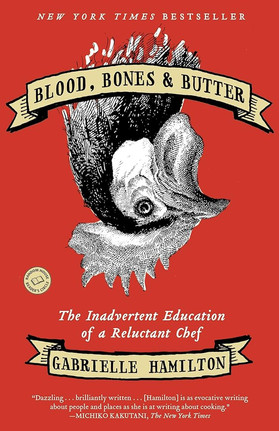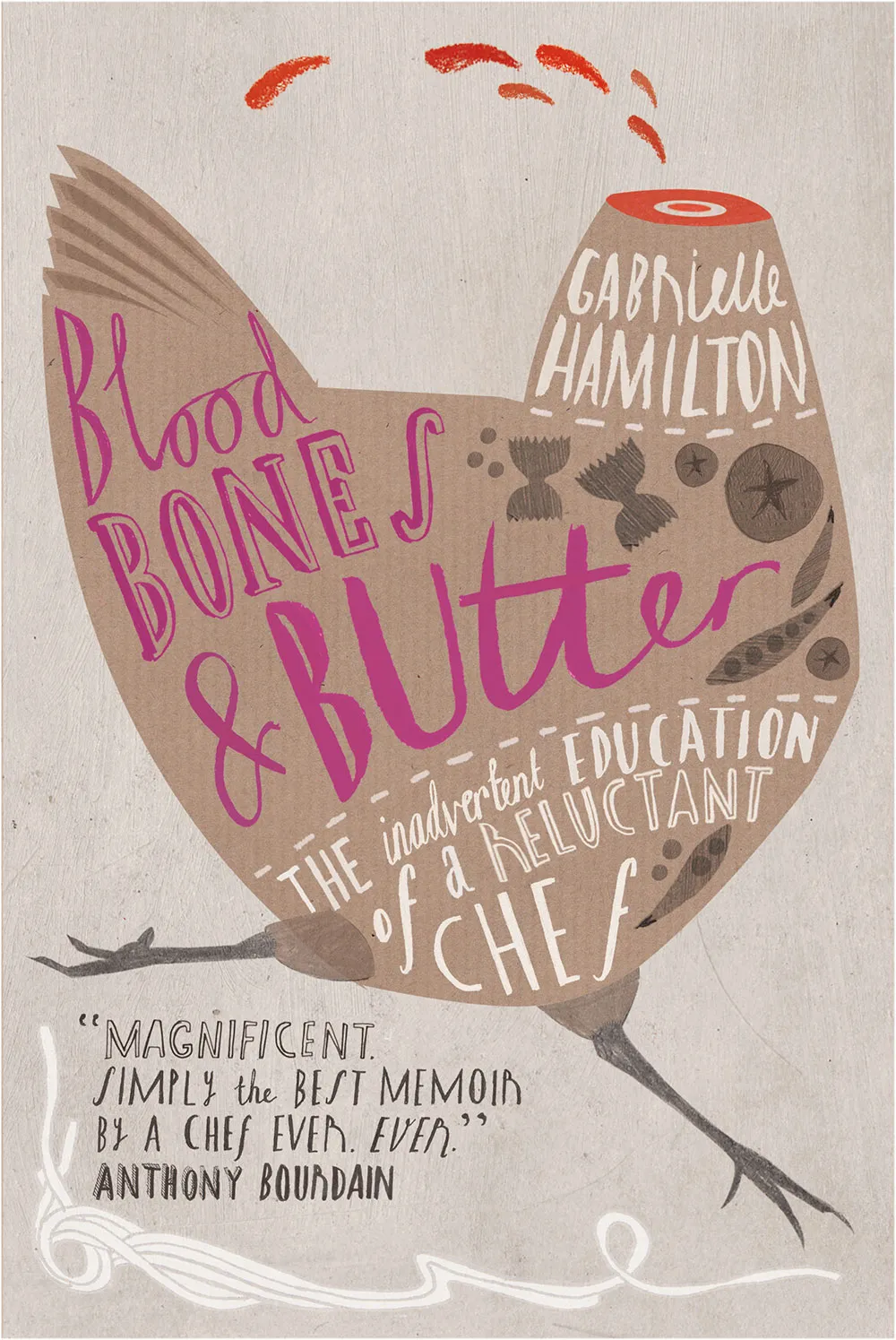Blood, Bones, and Butter by Gabrielle Hamilton
- Sep 26
- 7 min read
Updated: Oct 6
Blood, Bones & Butter: The Inadvertent Education of a Reluctant Chef is Gabrielle Hamilton’s acclaimed memoir that traces her unconventional path from a chaotic childhood in rural Pennsylvania and New Jersey to the creation of her celebrated New York City restaurant, Prune. Written with sharp, unsparing prose, the book blends food writing, personal history, and cultural commentary, making it a standout in both culinary and literary circles.
Blood, Bones, and Butter: The Inadvertent Education of a Reluctant Chef
Gabrielle Hamilton’s Blood, Bones, and Butter: The Inadvertent Education of a Reluctant Chef is a memoir that tracks a life shaped through food and hardship. She recalls a childhood marked by her mother’s rustic cooking and her father’s dramatic dinner parties, followed by years of turmoil, drifting work, and travel. Food is the thread that carries her through, from adolescence to Europe to the grueling labor of kitchens where she worked long before calling herself a chef.
The story builds toward the creation of Prune, Hamilton’s East Village restaurant, which becomes the expression of her personal history and culinary vision. The memoir explores family fractures, survival, and identity, demonstrating how the scars of her past are inextricably linked to her cooking. Blood, Bones, and Butter offers a raw, unsentimental account of how a reluctant chef carved out her place in the unforgiving world of restaurants and the food service industry.
Hamilton’s voice throughout the book is sharp, unsparing, and deeply personal, carrying the authority of someone who has lived every part of the work she describes. She writes of long nights in cramped kitchens, the sacrifices demanded by ambition, and the ways food shapes memory and a sense of belonging. Her memoir stands as both a portrait of a chef and a meditation on resilience, charting how one life, with all its ruptures, finds coherence through the act of cooking.
Key Takeaways
Childhood Memories Shape Culinary Passion and Identity
Gabrielle Hamilton’s earliest food memories came from her family’s annual spring lamb roast, a gathering that drew more than a hundred guests. Four or five lambs, each weighing around forty pounds, were roasted over an open fire while artists, dancers, and neighbors feasted in the meadow behind her home. These rituals of food and community set the foundation for her career, embedding in her both a love of hospitality and an instinct for cooking. Her influences came from many directions: a French mother who introduced refined flavors, the rural Pennsylvania landscape that provided fresh ingredients, the eclectic mix of guests who brought conversation and culture, and a household that adopted a hands-on approach, from foraging to whole-animal butchery.
Early Independence Forges Resilience and Culinary Skills
Hamilton’s independence began young, when she walked miles along train tracks to find work. Cooking became both survival and education, teaching her to make meals from whatever ingredients were on hand. Long shifts in diners, catering jobs, and other kitchens hardened her work ethic and sharpened her skills. Without formal culinary school, her training came from observation, repetition, and necessity. The result was a practical, no-frills approach to food and an ability to adapt to any kitchen, strengthened further by the range of cuisines she encountered in her working life.
Travel and Cultural Immersion Deepen Culinary Understanding
Backpacking through Europe and living abroad expanded Hamilton’s relationship with food far beyond technique. Immersed in unfamiliar kitchens and cultures, she learned the significance of local ingredients, regional dishes, and the hospitality that transcended language. Hunger at times, generosity at others, shaped how she thought about the meaning of cooking and serving. These experiences created a kind of culinary anthropology, giving her a clear understanding of food’s role in community and connection, and deepening her belief in simple, honest cooking that reflects place and people.
Restaurant Ownership: A Path of Challenge and Expression
Opening a restaurant was never part of Hamilton’s plan, yet the chance to launch Prune became the defining turn in her career. Without formal training in management, she faced steep challenges, but the restaurant offered her a canvas to shape her own philosophy of food and hospitality. Prune carried her imprint at every level, from menus drawn from travel and memory to the emphasis on simple, straightforward cooking free of pretense. The atmosphere mirrored a home kitchen, warm and unvarnished, even as Hamilton wrestled with the unrelenting demands of staffing, finances, and the constant fight to maintain quality.
Marriage to an Italian: Rich Traditions and Personal Strain
Hamilton’s marriage opened a window into Italian culture, most vividly through time spent in Italy. Trips to the country exposed her to regional cooking, authentic techniques, and a way of life centered on food as the heart of family. Her bond with her mother-in-law, Alda, provided lessons in tradition, heritage, and flavor that left a lasting imprint. Yet beneath these gifts, the marriage carried a strain. Differences in culture and communication, coupled with the difficulty of balancing career demands with family, left Hamilton often isolated and conflicted within her own household.
Motherhood and Career: A Relentless Balance
The pressures of being both chef and mother defined much of Hamilton’s life. Long hours at the restaurant meant missing mornings and evenings with her children, fueling guilt and emotional tension. Even as she poured herself into her work, she struggled to preserve creativity and passion while meeting the demands of family. In a male-dominated industry, she also faced the burden of proving herself, contending with stereotypes, and navigating the physical toll of the kitchen during pregnancy and motherhood.
Reconnecting with Family Through Food
Food became Hamilton’s way of repairing and reinforcing bonds. Cooking alongside her Italian mother-in-law bridged language gaps and turned ingredients into a means of conversation. With her children, shared meals offered moments of closeness and memory-making in a life otherwise marked by absence. Even estranged relationships, such as her own with her mother, found points of healing through the preparation of food. Across marriage, motherhood, and heritage, Hamilton relied on cooking as the truest expression of connection, care, and reconciliation.
Frequently Asked Questions
What is this book about?
Blood, Bones & Butter is Gabrielle Hamilton’s memoir tracing her life from the food-centered chaos of her childhood to her rise as a chef and owner of Prune in New York City. The book follows her path through family upheaval, solo travel, and years in tough restaurant kitchens, showing how those experiences forged both her identity and her culinary philosophy. Hamilton’s prose reflects her MFA training, capturing meals and moments with such detail that the reader is placed at her table.
Why should I read it?
This memoir stands out for its candor and precision. Food lovers will find vivid descriptions of dishes and the work that goes into them, while readers drawn to personal stories will encounter a raw account of survival, resilience, and self-discovery. The central takeaways are clear: genuine culinary knowledge emerges from lived experience, food carries cultural and emotional significance, and perseverance is as essential to a chef’s life as skill.
What are the key takeaways?
Hamilton shows that the foundation of her cooking came from immersion and repetition rather than formal training. The book illustrates how food is inextricably linked to memory and culture, bearing the weight of identity and connection. Her story also underscores endurance, showing how resilience carried her through fractured family life, demanding kitchens, and the challenges of building a career on her own terms.
What are the best quotes?
“I learned how to create beauty where none exists.” – A reflection on the cook’s ability to transform scarcity or disorder into care and nourishment.
“I had no clue that my parents were unhappy with each other.” – A reminder of how childhood often shields children from the realities of adult relationships, even as those realities shape their lives.
“I want to be relieved of making possibly poor decisions.” – A statement on hospitality, capturing how diners seek trust in a chef’s choices and the relief of surrendering responsibility at the table.
How does Hamilton define her personal identity?
Hamilton presents herself foremost as a cook, measured by the act of preparing and serving food rather than by formal titles or credentials. Her sense of self is shaped by family, most notably her Italian mother-in-law, Alda, whose cooking traditions anchor Hamilton’s understanding of heritage and belonging. Over time, the memoir traces her growth as she learns to balance the overlapping roles of chef, mother, and wife, each demanding its own kind of presence.
What challenges does Hamilton face in her culinary career?
The book details the relentless pressures of restaurant ownership, from financial strain to the constant need to uphold standards. Hamilton also writes about the challenges of being a woman in a field still dominated by men, where respect is often harder to earn. Added to this is the challenge of maintaining a family life while shouldering the demands of professional responsibility, a balance that remains precarious throughout her career.
Can you tell me about the theme of family?
Hamilton’s account of family is layered with both loyalty and conflict. She examines how family dynamics shaped her earliest ideas of love and obligation, and how food often served as the binding element in gatherings. The memoir portrays meals as repositories of memory, where dishes evoke the people and moments associated with them, underscoring food as a lasting link to the past.
About the Author
Gabrielle Hamilton is a chef, author, and founder of Prune, the influential New York City restaurant that earned acclaim for its unpretentious yet exacting approach to food. She was raised in a large, unruly household where her French mother instilled both discipline and a love of cooking in her. By her teens, she was working in kitchens, gaining experience that would later fuel her decision to open Prune, despite not having the benefit of formal culinary training. In addition to her restaurant career, Hamilton earned an MFA in creative writing, a background that shapes the sharp, precise style of her memoir Blood, Bones & Butter. Her work reflects independence, candor, and an unvarnished view of how food and family define a life.








Comments